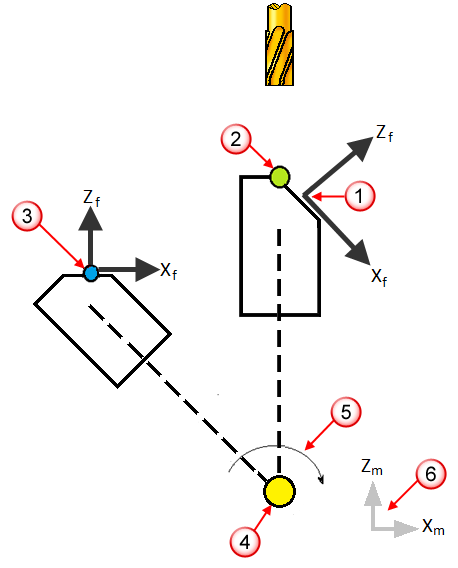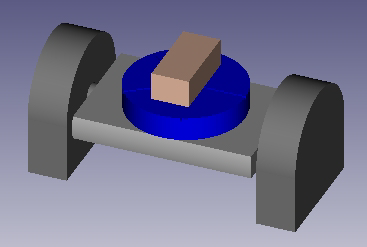Use the Table Settings dialog to define the dimensions and appearance of a 5-axis rotary table on a milling machine when using Basic Simulation for both box and cylinder stock.
To display this dialog, click Settings on the Setup dialog and select Rotary 5 Axis from the Table Type list.
The following settings are available:
Table Type — Select a table type. The dialog changes to reflect the table selected.
Primary Rotary Axis — Set the primary rotary axis to match your machine.
- X — Select this option if your Rotary 5 Axis table tilts about X. This is referred to as an A table.
- Y — Select this option if your Rotary 5 Axis table tilts about Y. This is referred to as a B table.
Use Turning in Job — Select to enable Turning in PartMaker/Mill. This option is available only if you have selected a Cylinder stock on the Setup dialog.
Global Origin — Specify the origin of the Global Coordinate System using the part origin, the table's pivot point, or a user-defined point:
- Part Origin
— Select so the NC coordinates are output with respect to the Part Origin (see
 ) in the Machine axes (see
) in the Machine axes (see
 ).
).
- Table Pivot Point — Select so the NC coordinates are output with respect to the Table Pivot Point (see
 ) in the Machine axes (see
) in the Machine axes (see
 ).
).

 This shows the Face Coordinate System when the part is at C=0, B=0.
This shows the Face Coordinate System when the part is at C=0, B=0.
 This shows the Part Origin when the part is at C=0, B=0.
This shows the Part Origin when the part is at C=0, B=0.
 This shows the Face Coordinate System when the part is rotated by both B and C angles.
This shows the Face Coordinate System when the part is rotated by both B and C angles.
 This shows the Pivot Point of the machines B-axis.
This shows the Pivot Point of the machines B-axis.
 This shows the machine's B-axis.
This shows the machine's B-axis.
 This shows the machine axes.
This shows the machine axes.
- User Defined — Select so the NC coordinates are output with respect to the point you specify in the Z Distance from Pivot Point field.
Z Distance from Pivot Point (Zd) — Specify the distance in Z of the global origin from the table pivot point.
Length (L) — Enter the length of the table.
Width (W) — Enter the width of the table.
Height (H) — Enter the height of the table.
Stock Extension (E) — Enter the length of stock section that protrudes from the chuck or other fixture. PartMaker uses this value for collision checking during simulation. This value is not required if you are using a setup assembly.
Indexing Time (min) — Enter the average index time for the table.
Pivot Distance (Pd) — Enter the distance from the middle of the table to the top-most edge of the stock. PartMaker uses this value to create the NC program output.
Chuck
Use Chuck — Select if you are using chuck on the table.
Chuck Data — When a chuck is used, click this button to display the Chuck Data dialog where you can specify details about the chuck.
Simulation Settings
Use these settings to specify how you want the table to appear during Basic Simulation:
Table Transparency — Enter the transparency of the table when displayed in the Simulation window, where 0% displays a solid table and 100% displays a fully transparent (invisible) table.
Table Color — Click to display the Color dialog, where you can specify the color of the table during simulation.
Machine File — Click this button to display the Machine File dialog, which enables you to import settings from a machine file or export settings to a machine file.
Displaying the rotary table in simulation
You can display the rotary table in simulation by modifying the chuck data:
- Select the Use Chuck option on this dialog.
- In the Chuck Data dialog, set Jaw Transparency to 100%.
